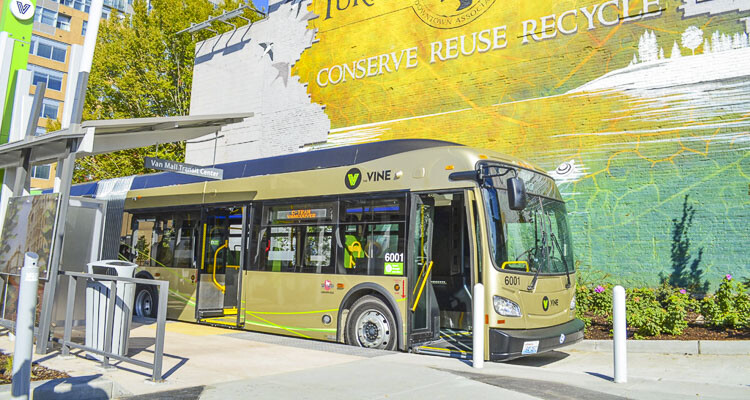C-Tran BRT seats 50 percent more people than MAX light rail
John Ley
For Clark County Today
Why isn’t the C-TRAN Board of Directors fighting to have C-TRAN provide the high-capacity cross river transit service, for the Interstate Bridge Replacement (IBR) project? Aren’t each of the board members obligated to serve the best interests of Clark County citizens and our C-TRAN mass transit service?
Why aren’t they telling the truth about C-TRAN offering lower cost service via their Bus Rapid Transit (BRT) system, compared to the much higher cost of TriMet’s light rail?

The Interstate Bridge Replacement (IBR) team is telling people that transit currently serves 1.7 percent of Columbia River crossings. They are projecting a fantasy – 26,000 to 33,000 transit passengers on the I-5 corridor across the river by 2045. They have yet to show how many buses and trains the 26,000 people would need each day.
TriMet revealed to the 16-member Bi-state Bridge Committee of legislators last week they expect the light rail component of the IBR would cost between $1 billion and $1.3 billion to build. You could buy 1,300 of the double-articulated BRT buses or 2,600 regular buses for that price.
C-TRAN offers the only cross river transit service, so the board should know the reality. Ridership across the Columbia has declined significantly, but the decline began a decade ago. The board cut service significantly a year ago. We’re down below 1,000 boarding riders a day on C-TRAN’s express bus service to Portland.
The IBR has chosen TriMet’s light rail, saying it is cheaper to operate on a “per passenger” basis. The C-TRAN Board knows better. C-TRAN’s Vine BRT costs $5.44 per boarding passenger in 2020. They originally told the Federal Transit Administration their cost per boarding passenger would be $3.68.
Two years ago, the TriMet MAX light rail cost per boarding passenger was 51 percent higher, at $8.24 per boarding rider. TriMet reports in 2021 the cost per boarding rider on their MAX light rail was $9.08.
C-TRAN’s BRT buses offer better service than MAX light rail. The Yellow Line travels 14 miles per hour because it has to stop every mile. Our C-TRAN express buses travel nearly double that speed, and would travel even faster if allowed to use I-5 shoulders for bus-on-shoulder service. How many of our citizens want to travel 14 mph?
The BRT buses offer seats for 60 percent of their passengers – 50 percent more than the MAX Yellow Line trains, which only seats 40 percent of their passengers. Would any six of the 10 board members be willing to stand up for their entire meeting? That’s what the IBR team wants – 60 percent of transit passengers to be forced to do to.
C-TRAN buses could offer faster express transit service from all over Clark County, whereas TriMet’s MAX can only serve people where the rails are put down. The Cascade Policy Institute has documented the failure of TriMet light rail to attract promised ridership.
The IBR team is proposing to spend $5 billion. They will replace a 3-lane bridge with another 3-lane bridge. Travel times for Clark County residents will double on I-5 by 2045. It will take an hour to go from the I-205 interchange at Salmon Creek, to the I-405 interchange at the Fremont Bridge after spending $5 billion.
None of this makes sense. A BRT line could be built for $50 million. A TriMet representative told the committee of 16 legislators providing oversight to the IBR they expect the light rail proposal to cost between $1 billion and $1.3 billion. That’s a 50 percent increase from the failed CRC a decade ago.
The C-TRAN board should fight to offer our cheaper, better, and faster BRT service for the Interstate Bridge project. They should also fight to stop the waste of $5 billion of our tax dollars.
Also read:
- Opinion: Hiding the growing cost of the Interstate Bridge replacementJoe Cortright of the City Observatory addresses the rising cost of the Interstate 5 Bridge replacement project.
- 90 minutes of delay on Southbound I-5 in Southwest Washington on Friday afternoon, July 26Travelers using southbound Interstate 5 through Woodland should expect up to 90 minutes of delay during Friday afternoon and evening and should delay travel or prepare for additional travel time.
- Nighttime paving work on I-5 and SR 14 in Clark County July 28-Aug. 9Nighttime travelers in Clark County should expect delays for maintenance and paving work beginning Sunday, July 28 until the morning of Friday, Aug. 9.
- Northeast 182nd Avenue/Northeast Ward Road to be closed on Aug. 1Northeast 182nd Avenue and Northeast 172nd Avenue in Clark County will have single-day closures on August 1 and August 5 for road preservation, with detours in place.
- Interstate Bridge Replacement program awarded $1.499 billion FHWA Bridge Investment Program grantInterstate Bridge Replacement program officials have shared that the program received $1.499 billion through the Federal Highway Administration’s Bridge Investment Program.









